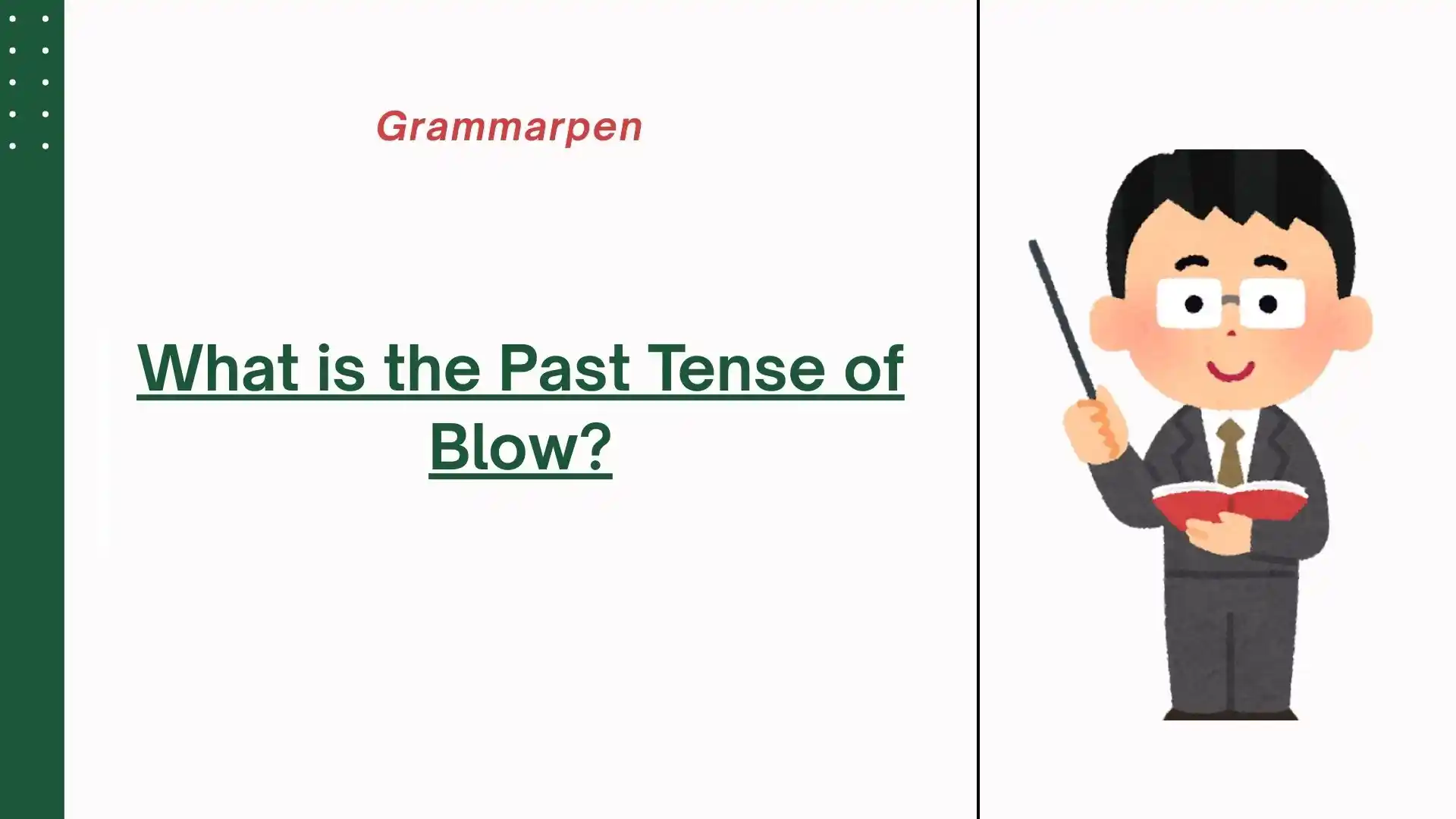What is the Past Tense of Blow?

The verb “blow” means to produce a current of air by exhaling, to move air or cause it to move, or to propel something by the force of air.
It is also used in figurative senses, such as “to blow an opportunity” or “to blow up a situation.” In English grammar, “blow” is an irregular verb, which means its past tense does not follow the usual pattern of simply adding “-ed.”
The correct past tense of “blow” is “blew.” This form changes both the vowel and the spelling, making it distinct from the base form. For example, “I blow out the candles” in the present tense becomes “I blew out the candles” in the past tense.
READ ALSO: What Is the Past Tense of Smells?
Why is the Past Tense of Blow Irregular?
The irregularity comes from the historical development of the English language. “Blow” originates from the Old English word “blawan,” which followed a strong verb pattern where vowels shifted to form past tense.
In the case of “blow,” the vowel “o” changes to “ew,” giving us “blew.” According to linguistic research, such vowel changes, known as ablaut, are a feature inherited from Proto-Germanic and preserved in many English irregular verbs like “grow/grew” and “know/knew.”
University grammar studies have documented that these shifts have remained stable over centuries because they are deeply rooted in spoken tradition.
How Do You Use Blew in Sentences?
“Blew” is used to describe an action that happened in the past and is now complete. It can refer to both literal and figurative actions.
-
Literal air movement example: “The wind blew the papers off the table during the storm.”
-
Figurative missed opportunity example: “He blew his chance to win the competition by arriving late.”
-
Descriptive action in storytelling: “She blew across the hot coffee before taking a sip.”
-
Emotional intensity example: “The crowd blew up in excitement when the team scored.”
Each of these examples demonstrates a different context in which “blew” applies, helping learners see its versatility.
What is the Past Participle of Blow and Why is it Important?
While the past tense is “blew,” the past participle of “blow” is “blown.” This form is essential when constructing perfect tenses or passive voice sentences. For example:
-
Present perfect: “The referee has blown the whistle to end the match.”
-
Past perfect: “They had blown all their savings before they found new jobs.”
-
Passive voice: “The glass was blown by a skilled craftsman.”
Understanding the difference between “blew” and “blown” prevents grammar mistakes, especially in advanced writing and speaking.
Common Mistakes When Using Blew
One frequent error is confusing “blew” with “blown” in past tense usage. Remember that “blew” stands alone as the simple past, while “blown” needs an auxiliary verb.
Another mistake is spelling; some learners mistakenly write “bluw” or “blou.” Research in language acquisition shows that irregular verbs are more prone to spelling and tense errors because they do not follow predictable rules.
READ ALSO: What is the Plural of Analysis?
Can Blew Be Used Figuratively?
Yes, “blew” is rich in idiomatic and figurative meanings. It can mean wasting a chance (“She blew the interview”), becoming very angry (“He blew up when he heard the news”), or surprising someone (“The magician’s trick blew my mind”).
These figurative uses are common in spoken English and appear often in literature, journalism, and casual conversation.
Graphical Guide: Tense Forms of Blow
Below is a visual representation showing how “blow” changes across tenses.
Base Form → Blow
Past Tense → Blew
Past Participle → Blown
This simple transformation pattern can be memorized more easily when visualized, and it helps distinguish between different grammatical contexts.
How Does Blew Compare to Other Irregular Verbs?
“Blow” belongs to a group of verbs that shift their internal vowel rather than adding a suffix. Similar verbs include “grow/grew,” “fly/flew,” and “know/knew.”
In all these cases, the vowel change carries the tense distinction, and learners who master one set often find it easier to remember others.
Historical and Linguistic Notes
The survival of “blew” instead of a regularized “blowed” shows the influence of oral tradition on English grammar. Scholars from the University of Cambridge note that children often learn such irregular forms early because they appear frequently in storytelling, songs, and common phrases. The stability of “blew” across centuries underlines the cultural importance of certain verbs.
Practical Tips for Remembering Blew
-
Associate it with other “-ew” past tense forms, like “flew” and “drew.”
-
Practice with idioms, such as “blew it,” “blew off steam,” and “blew the lid off.”
-
Read narratives where “blew” appears naturally to reinforce memory.
-
Write short stories or diary entries using “blew” in different contexts.
READ ALSO: What is the Past Tense of Fall?
Frequently Asked Questions
1. Is “blew” ever used in the present tense?
No. “Blew” is only for past tense. The present tense remains “blow,” as in “They blow the horn every morning.”
2. What is the difference between “blew” and “blown”?
“Blew” is the simple past tense. “Blown” is the past participle and must be used with an auxiliary verb.
3. Can I say “blowed” instead of “blew”?
No. “Blowed” is considered nonstandard and incorrect in modern English, although it appears in some dialects and historical texts.
4. Does “blow” change in the continuous tense?
Yes. In continuous forms, “blow” becomes “blowing,” such as “The wind is blowing strongly today.”
5. Is “blew” used in formal writing?
Yes. It is accepted in all levels of writing, from academic essays to casual notes, as long as it fits the time frame of the action.
